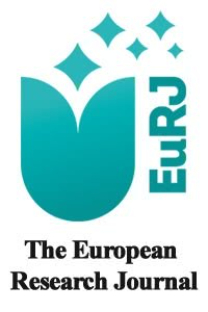The possible effect of light exposure reduction via eye patches after the examination for retinopathy in premature infants? An observational study in preterm neonates
The possible effect of light exposure reduction via eye patches after the examination for retinopathy in premature infants? An observational study in preterm neonates
Newborn, eye patch, light exposure, retinopathy of prematurity, non-pharmacological method,
___
- 1. Szigiato AA, Speckert M, Zielonka J, Hollamby K, Altomare F, Ng E, et al. Effect of eye masks on neonatal stress following dilated retinal examination: The MASK-ROP randomized clinical trial. JAMA Ophthalmol 2019;137:1265-72.
- 2. Uslu S, Bülbül A. [Retinopathy of prematurity via neonatology perspective]. Şişli Etfal Hastanesi Tıp Bülteni 2011;45:142-52. [Article in Turkish]
- 3. Koç E, Yağmur Baş A, Özdek Ş, Ovalı F, Başmak H. Turkish Neonatal and Turkish Ophthalmology Societies consensus guideline on the retinopathy of prematurity. Turk Pediatr Ars 2018;53:151-60.
- 4. Bas AY, Koc E, Dilmen U, ROP neonatal Study Group. Incidence and severity of retinopathy of prematurity in Turkey. Br J Ophthalmol 2015;99:1311-4.
- 5. Löfqvist C, Andersson E, Sigurdsson J, Engström E, Hård AL, Niklasson A, et al. Longitudinal postnatal weight and insulin-like growth factor I measurements in the prediction of retinopathy of prematurity. Arch Ophthalmol 2006;124:1711-8.
- 6. Hellström A, Carlsson B, Niklasson A, Segnestam K, Boguszewski M, de Lacerda L, et al. IGF-I is critical for normal vascularization of the human retina. J Clin Endocrinol Metab 2002;87:3413-6.
- 7. Early Treatment For Retinopathy Of Prematurity Cooperative Group. Revised indications for the treatment of retinopathy of prematurity: results of the early treatment for retinopathy of prematurity randomized trial. Arch Ophthalmol 2003;121:1684-94.
- 8. Fierson WM; American Academy of Pediatrics Section on Ophthalmology; American Academy of Ophthalmology; American Association for Pediatric Ophthalmology and Strabismus; American Association of Certified Orthoptists. Screening examination of premature infants for retinopathy of prematurity. Pediatrics 2013;131:189-95.
- 9. Fierson WM; American Academy of Pediatrics Section on Ophthalmology; American Academy of Ophthalmology; American Association for Pediatric Ophthalmology and Strabismus; American Association of Certified Orthoptists. Screening examination of premature infants for retinopathy of prematurity. Pediatrics 2018;142:e20183061.
- 10. Mitchell AJ, Green A, Jeffs DA, Roberson PK. Physiologic effects of retinopathy of prematurity screening examinations. Adv Neonatal Care 2011;11:291-7.
- 11. Dilli D, Soylu H, Tekin N. Neonatal hemodynamics and management of hypotension in newborns. Turk Pediatri Ars 2018;53(Suppl 1):65-75.
- 12. Benbrook K, Manworren RCB, Zuravel R, Entler A, Riendeau K, Myler C, et al. Agreement of the neonatal pain, agitation, and sedation scale (N-PASS) with NICU nurses' assessments. Adv Neonatal Care 2023;23:173-81.
- 13. Marlier L, Gaugler C, Astruc D, Messer J. [The olfactory sensitivity of the premature newborn]. Arch Pediatr 2007;14:45-53. [Article in French]
- 14. Belda S, Pallás CR, De la Cruz J, Tejada P. Screening for retinopathy of prematurity: is it painful? Biol Neonate 2004;86:195-200.
- 15. Espino-torres E, Malloy M, Geary C. Eye patches reduce the pain and distress in infants undergoing pupillary dilation for the screening of retinopathy of prematurity. Poster presented at: 2012 Texas Pediatric Society Electronic Poster Contest 2012.
- 16. Johnston CC, Fernandes AM, Campbell-Yeo M. Pain in neonates is different. Pain 2011;152(3 Suppl):65-73.
- 17. Moral-Pumarega MT, Caserío-Carbonero S, De-La-Cruz-Bértolo J, Tejada-Palacios P, Lora-Pablos D, Pallás-Alonso CR. Pain and stress assessment after retinopathy of prematurity screening examination: indirect ophthalmoscopy versus digital retinal imaging. BMC Pediatr 2012;12:132.
- 18. Yiğit Ş, Ecevit A, Köroğlu ÖA. Turkish Neonatal Society guideline on the neonatal pain and its management. Turk Pediatri Ars 2018;53(Suppl 1):161-71.
- ISSN: 2149-3189
- Yayın Aralığı: 6
- Başlangıç: 2015
- Yayıncı: Prusa Medikal Yayıncılık Limited Şirketi
Feyza SÖNMEZ TOPCU, Şirin YURTLU TEMEL
Burcu AYDIN BOYAMA, Emine Zeynep YILMAZ
Melin GECER, Nur BÜYÜKPINARBAŞILI, Seval TURNA, Mehmet BEŞİROĞLU, Zuhal GUCIN
Fatih KOCA, Fatih LEVENT, Ahmet Kağan AS, Fatih KÖKSAL, Ahmet Burak TATLI, Fahriye VATANSEVER, Mehmet DEMİR, Erhan TENEKECİOĞLU
Prognostic factors in atypical carcinoid tumors
Ahmet Bilgehan ŞAHİN, Erdem ÇUBUKÇU, Adem DELİGÖNÜL, Birol OCAK, Huseyin MELEK, Buket ERKAN OZMARASALİ, Burcu CANER, Ahmet BAYRAM, Elif Ülker AKYILDIZ, Türkkan EVRENSEL
Tufan GÜNAY, Dursun TOPAL, Suat AKGÜR
Mustafa KAPLANGORAY, Kenan TOPRAK, Cihan AYDIN, Ramazan ASLAN
